Check | Artificial synthetic "fake meat", do you dare to eat it?
Original nuclear record NJU nuclear record
150 th issue
Editor | Sheng You and Peng Yue
Reporter | Lin Yuyao Chen Zixuan Hong Yidong Xu Leijie
Xu Leijie
On November 18, 2019, Professor Zhou Guanghong from the National Meat Center of Nanjing Agricultural University led a team to use the sixth generation of pig muscle stem cells to obtain artificial pork weighing 5 grams after 20 days of culture. This is the first artificial meat made from animal stem cells in China.
A week later, a vegetable protein artificial meat of OmniPork’s new pork was officially launched on Tmall platform, with a price of 230g per serving in 28 yuan. As a result, artificial meat is stepping on the table of Chinese people step by step. While feeling novel, many people are also worried about this kind of unnatural "fake meat".
What exactly is artificial meat? According to Wikipedia, artificial meat is usually divided into two categories: plant meat and cultivated meat. Plant meat refers to food products made from plant raw materials, which imitate the taste, taste or appearance of animal meat. The OmniPork new pork mentioned above is such artificial meat.
Cultured meat refers to the meat made by cultivating animal muscle cells through bioengineering, and what Professor Zhou Guanghong’s team cultivated is cell cultured meat.
Qianjiang evening news published the report "Artificial Meat, Is It Really Unacceptable?" on November 26th, 2019, saying that artificial meat was produced to fill the gap between supply and demand of natural meat, and at the same time it may be healthier and more environmentally friendly.

(Original qianjiang evening news)
Is the supply and demand of natural meat unable to meet people’s needs? Does natural meat cause environmental pollution and resource consumption? Is artificial meat more nutritious than natural meat? Artificial meat does not contain antibiotics and can artificially control nutrients? After checking the above questions, the reporter of the nuclear record came to the conclusion:
1. China’s domestic natural pork market is in short supply and demand;
2. The production and consumption of natural meat pollutes the environment and consumes a lot of resources;
3. At present, the calories, fat and cholesterol of artificial meat on the market are lower than those of real pork, but the content of protein is not as good as that of real pork;
4. Vegetable protein artificial meat does not contain traditional animal antibiotics, but only the cell-cultured meat in the laboratory can artificially control the nutritional components.
Checkpoint 1: Is China’s natural pork unable to meet the market demand?
A: At this stage, the domestic pork market is tight in supply and demand, and the import volume has increased significantly.
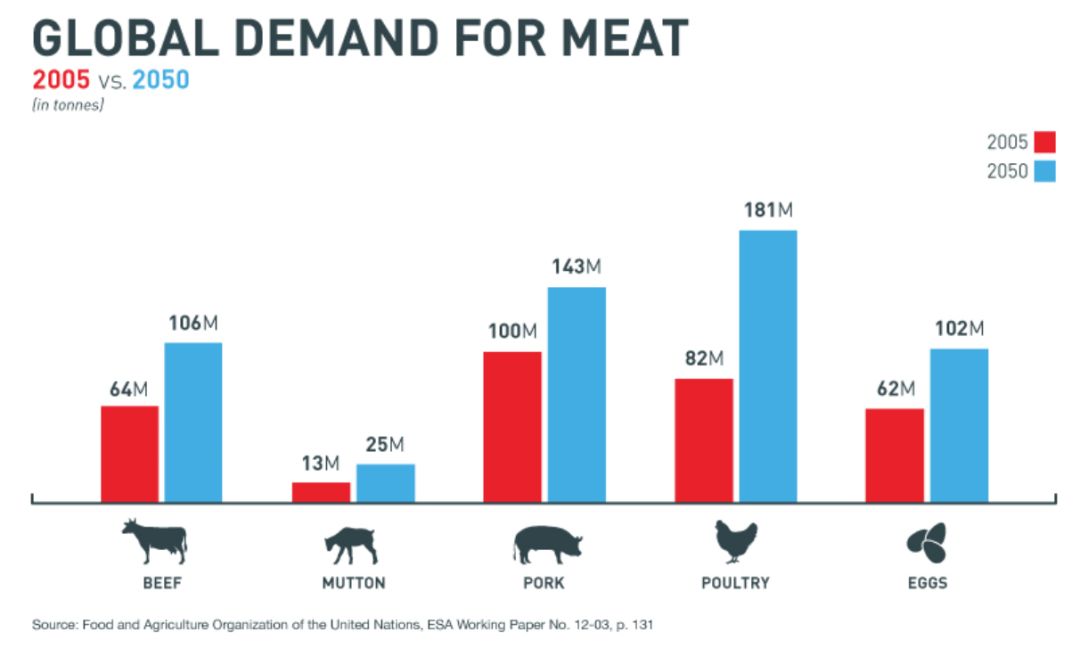
(Source: The Food and Agriculture Organization of the United Nations is taken from Bill Gates’ blog)
Bill Gates is a supporter of artificial meat. He has invested in many artificial meat producers such as Impossible Foods, Beyond Meat. Qianjiang evening news quoted a quote from Bill Gates’ blog: "It’s good news that economic growth has made meat affordable for more people, but the bad news is that by 2050, the demand for meat we need will double that of 2005. However, we don’t have that much land for grazing. "
Is the emergence of artificial meat because the market supply of natural meat can’t match the market demand? In view of the demand of natural meat in China market, the reporter took pork as an example and made a verification.
The reporter found the Statistical Yearbook of China from 1999 to 2019 on the website of the National Bureau of Statistics, which counted the pork production in China in the past 20 years. According to the data of the National Bureau of Statistics, the pork production in China increased from 31.58 million tons in 1996 to 54.03 million tons in 2018, which nearly tripled in 22 years. According to the data of the OECD database (https://stats.oecd.org/), the pork consumption in China increased from 31,365,200 tons in 1996 to 55,218,900 tons in 2018.
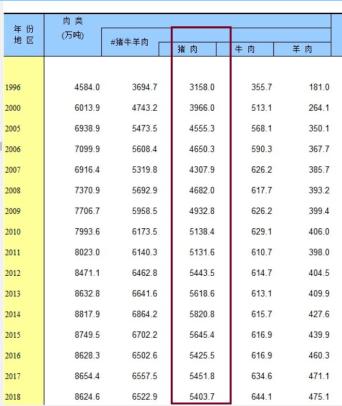
(Source: National Bureau of Statistics)
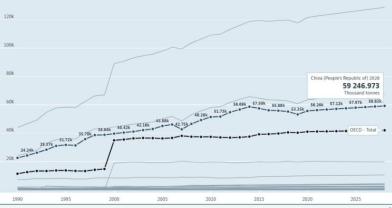
(OECD network: pork consumption in China)
As for the import and export volume, according to the data of China Agricultural Industry Development Report 2019, the pork import volume in China has started to increase significantly since 2010.
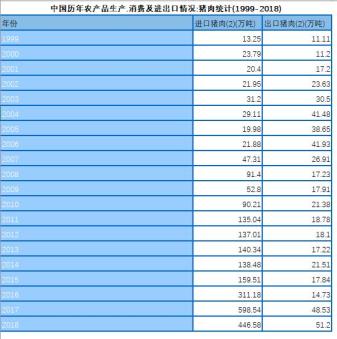
(Source: China Agricultural Industry Development Report 2019)
We calculated by the formulas of [pork production-pork consumption] and [(pork production+pork import)-(pork consumption+pork export)], and got the following results respectively:
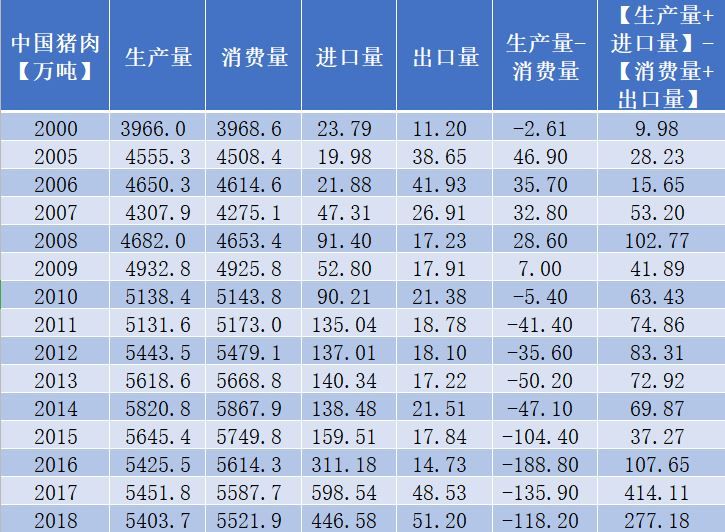
(The author calculated according to the data of China Agricultural Industry Development Report 2019, OECD Network and National Bureau of Statistics)
It can be seen that although China’s pork market maintains a balance between supply and demand under the compensation of imports, the annual production has been less than the annual consumption since 2010, and the gap has been expanding. Correspondingly, the import volume of pork increased by 17.77% from 2000 to 2018, and the supply and demand of domestic pork market tended to be tight.
In 2019, due to African swine fever, a series of prevention and control policies and changes in slaughter, the domestic slaughter of pigs decreased significantly, and the production capacity of pigs and fertile sows continued to decline. The effect of tight supply in the pork market was concentrated during this period, leading to a sharp rise in domestic pork prices.
Based on the above materials, the demand for pork products in China is increasing, and the shortage of supply and demand in the domestic natural pork market will become increasingly prominent.
Checkpoint 2: Does the production and consumption of natural meat cause environmental pollution and massive consumption of resources?
A: The production and consumption of natural meat will pollute the atmosphere and require a lot of land and water resources.
"qianjiang evening news" reported that "livestock manure will pollute land and water sources, and their farts contain a lot of methane, and the greenhouse effect of methane is 25 times higher than that of carbon dioxide. Animal husbandry has caused considerable pressure on the environment. There is no excreta in artificial meat, and three-dimensional production takes up very little land. "
According to the greenhouse gas emissions of pig breeding, the reporter consulted the article "Development of China’s Pork Industry and Estimation of Greenhouse Gas Emissions" published in China Pig Industry in October 2015. By calculating the emissions of methane in pig intestines, methane in feces and nitrous oxide in feces (methane and nitrous oxide are listed as greenhouse gases by intergovernmental climate change organizations), it is concluded that in 2012, only 112 million tons of greenhouse gases were emitted during pig breeding (excluding other processes).
Not only that, Xu Wenchuan, School of Environment, Nanjing University, published his master’s degree thesis "Analysis of Greenhouse Gas Emissions from China Residents’ Dietary Consumption" in May 2018, pointing out that the greenhouse gas emissions from pork in China’s dietary consumption (including the whole process of breeding) have been increasing from 252 million tons in 2002 to 325 million tons in 2012 (Figure 1), and the proportion has also been rising, from 27% to 28% (Figure 2 Compared with the 7.954 billion tons of national greenhouse gas emissions in 2012 pointed out by China Carbon Emissions Trading Network, this number accounts for about 4.1% of China’s total greenhouse gas emissions.

(Figure 1 Source: "Analysis on the Changes of Greenhouse Gas Emissions of China Residents’ Dietary Consumption")
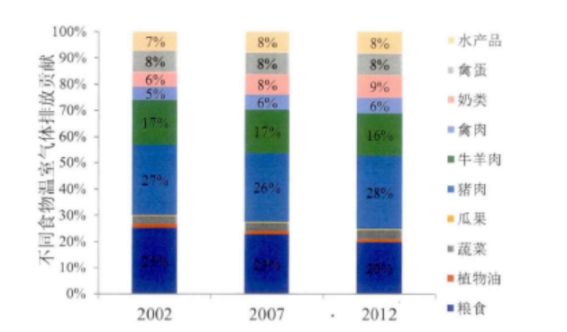
(Figure 2 Source: "Analysis on the Changes of Greenhouse Gas Emissions of China Residents’ Dietary Consumption")
Regarding the consumption of land and water resources in pork production, the reporter looked through the data of the 8th LCA International Conference on Agricultural Food held in Rennes, France in October 2012. According to the statistics of the organization in charge of the conference, the output of each ton of edible pork needs 4.9m3 of water resources (see the figure below), and beef, mutton and other meats consume more.
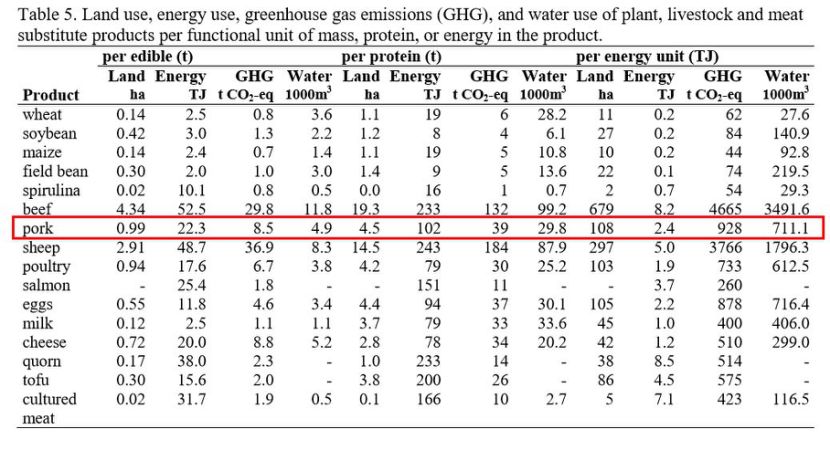
(Source: Report of the 8 th LCA International Conference on Agricultural Food)
According to the data of the first verification point, the domestic consumption of pork in China in 2018 is about 55.22 million tons, which requires about 270.5 billion cubic meters of water resources according to the above-mentioned meeting data. According to the "China Water Resources Bulletin 2018" published by the Ministry of Water Resources of People’s Republic of China (PRC), the total domestic water consumption in 2018 is only 85.99 billion cubic meters, so the water consumption used only for pork production in that year can supply the daily life of the people of the whole country for at least three years, and if other meats are added, it will be more.
At the same time, meat production based on animal husbandry consumes a lot of land resources. According to the comparative analysis of environmental impacts of agricultural production systems published by Clark & Tilman in the journal Environmental Research Letters, According to the data in the article "Agricultural input efficiency, and food choice", the production of pork in protein requires 0.13 square meters of land, while that of beef and mutton in protein requires 1.02 square meters.
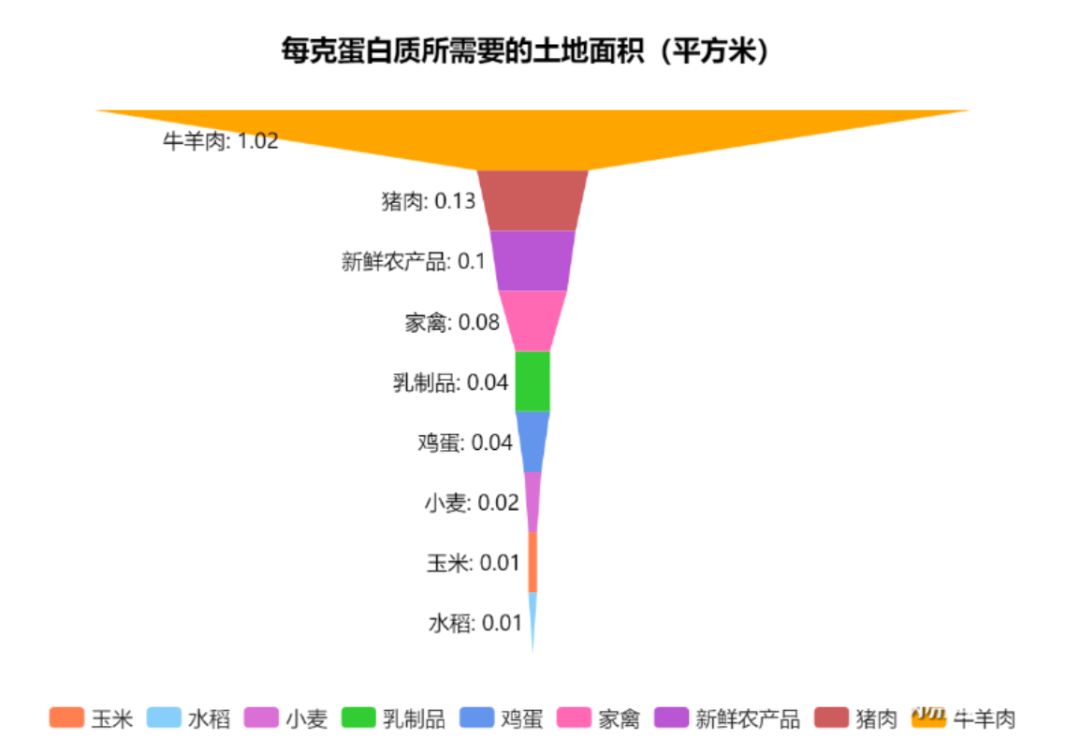
(source: comparative analysis of environmental impacts of agricultural production systems, agricultural input efficiency, and food choice)
However, the data of the National Bureau of Statistics show that the available grassland area in China is decreasing year by year. From 2003 to 2018, the available grassland in China decreased from 3.31 million square kilometers to 2.194 million square kilometers. The reduction of grassland area limits the development space of animal husbandry, and also confirms the worry that "there is no more land for grazing" in Bill Gates’ blog.
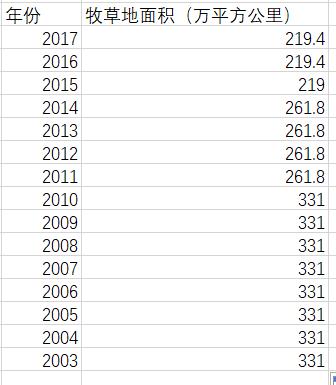
(Data source of grassland area change in China: Statistical Yearbook of National Bureau of Statistics)
Based on the above information, the production and consumption of natural meat have indeed caused the problems of environmental pollution and massive consumption of resources.
Checkpoint 3: Artificial meat is low in calories, fat and cholesterol, and has higher nutritional value?
A: Compared with real pork, OminPork artificial meat currently on the market in China has lower calorie and fat content and zero cholesterol, but its protein content is also slightly lower.
Qianjiang evening news reported that "artificial meat may be healthier than natural meat. Artificial meat production process does not need to use antibiotics, but also can artificially control the nutrients in the meat. According to the data, this artificial meat (which was reported to be listed on the e-commerce platform on November 25th, 2019) has just been marketed and retailed with plant-derived protein as raw material. Compared with real pork, the fat is 70% lower, the calorie is 65% lower, and the cholesterol is 0. Moreover, in the case of the same protein content as pork, the iron and calcium contents are 2-3 times higher than pork. "
The reporter inquired that the artificial pork currently listed in China is only OminPork new pork, which is taken as a representative for verification. This artificial meat is a future meat product developed by Right Treat, a food research company of Hong Kong Green Monday Company, and sold through the Green Common Tmall international platform. This is a kind of vegetable protein meat, the main ingredients are water and plant protein concentrate such as soybean, mushroom and rice.
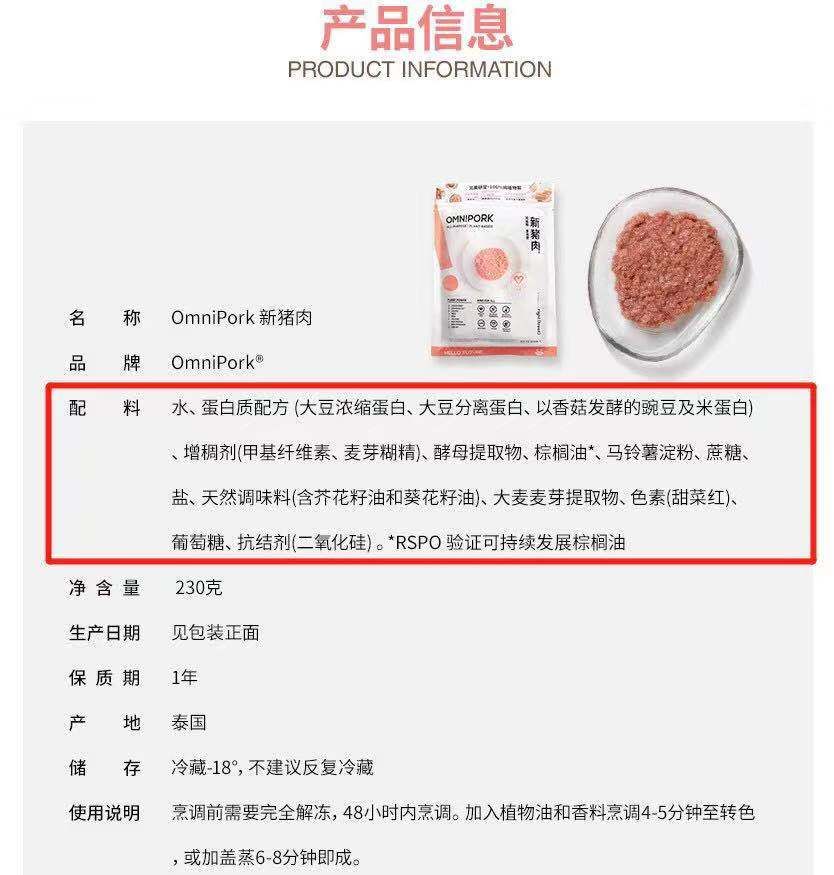
(Chinese version of ingredient list provided by Tmall International)
The ingredient list displayed in the official flagship store of Green Common shows that the artificial meat has an energy of 74 kilocalories per 100g, a fat content of 1.5g and a cholesterol content of 0. If we compare the composition of this artificial meat with that of real pork with 84% lean meat and 16% fat meat, then this artificial meat is 66% lower in calories and 68% lower in saturated fat than real pork.
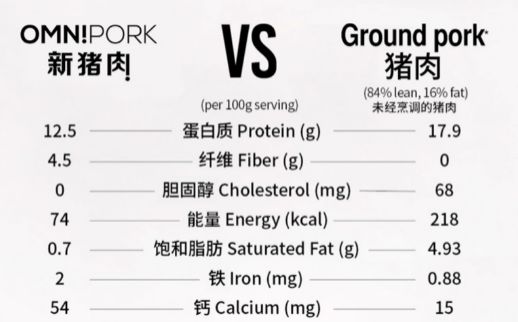
(ingredient list in the official flagship store of Green Common)
There are differences between the above product data and the data mentioned in the report of qianjiang evening news: the data expression of fat, energy and cholesterol are basically the same; However, it is worth noting that the protein content of this artificial meat is 12.5g, which is slightly lower than that of real pork (17.9g), which contradicts the reported "protein content is the same". At the same time, this artificial meat has 2.6 times the calcium and 1.27 times the iron content of ordinary pork, rather than the vague "2-3 times" in the report.
In addition, the report doesn’t mention the fat-lean ratio of real pork (lean meat: fat meat ≈ 84: 16), and different fat-lean ratios will lead to different nutritional components of pork, which may further affect readers’ understanding of the nutritional value of artificial meat.
Checkpoint 4: Artificial meat does not need antibiotics, and can the nutrients in the meat be artificially controlled?
A: Vegetable protein meat does not need antibiotics, but only cell-cultured meat can artificially control nutrients.
The article "Characteristics of Plant Extracts and Their Application in Sow Production" published in Journal of Animal Nutrition in 2017 indicates that the abuse of antibiotics in large-scale pig farms is very serious, which will not only lead to antibiotic residues in meat products, but also lead to the emergence of drug-resistant bacteria, which seriously threatens human health. It can be seen that farmers add antibiotics to feed, and antibiotics remain in pigs, so there is a saying that "natural meat contains antibiotics".
In contrast, the ingredient list of OminPork mentioned above shows "no added antibiotics".

(ingredient list in the official flagship store of Green Common)
As for the idea that "nutrients can be artificially controlled" in qianjiang evening news, the reporter of the Nuclear Record found through investigation that this is mainly aimed at cultivating meat.
According to Wikipedia’s definition, the principle of cultivating meat is to extract stem cells from animals, then put them in test tubes or Petri dishes to divide and grow, and finally produce muscle tissue, in which the nutrients can be controlled.
As early as 2005, the team of Jason Masini, Ph.D., who studied agricultural economy and public health at the University of Maryland, put forward two technologies with large-scale meat production potential in the scientific journal Tissue Engineering. In response to these two methods, Masini said: "You can even control nutrition. For example, most meat has high omega-6 fatty acids, and artificial meat can be replaced by omega-3, which is a healthy fat."
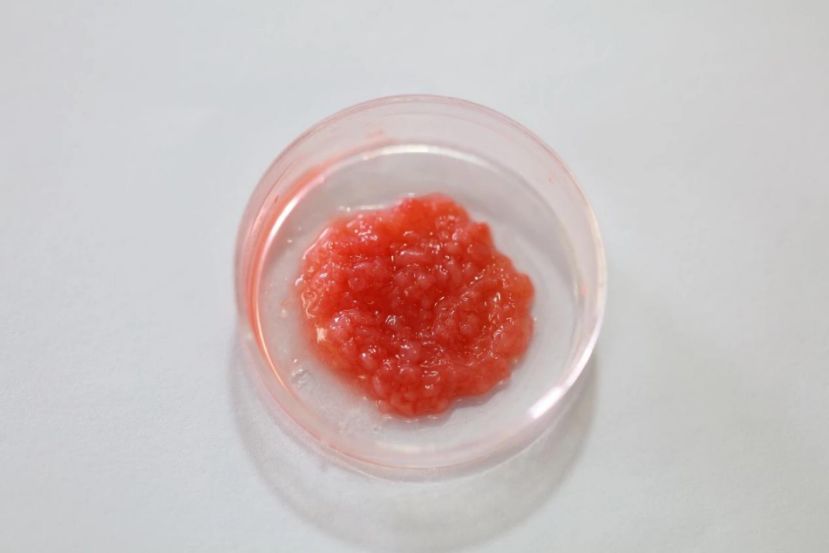
(Artificial meat cultivated by Professor Zhou Guanghong led the team. Source: "National Meat Center" WeChat official account)
However, as mentioned above, the argument that artificial meat can artificially control nutrients is limited to cell culture of meat in vitro, and it is unlikely that this technology will be popularized to the market on a large scale. According to the report of "Global Network" on November 25th, 2019, "When did China artificial meat come to the people’s table? Expert: Lobster with Super Price, experts from College of Animal Science and Technology of China Agricultural University and Beijing Agricultural College think: "(China) is still in the research and development stage. With the current technology, a large amount of animal serum needs to be added to the system of cultivating cell meat, and the serum comes from blood, so animals must be slaughtered in order to obtain serum. In addition, it is still in the early stage of research and development, and it needs to invest a lot of manpower and material resources. The cost of artificial meat far exceeds that of ordinary meat."

(The World Wide Web reported, "When did China artificial meat come to the people’s table? Expert: Super-priced Lobster)
To sum up, this report is suspected of confusing two types of artificial meat with each other. For vegetable protein artificial meat, because vegetable protein is used, animal antibiotics are not used. However, the so-called "artificial control of nutrients" is only used for cultivating meat in the laboratory, and it is unlikely that this technology will be popularized to the market at this stage.
summary
At present, the supply and demand of China’s meat market is relatively tight, and traditional animal husbandry has caused a lot of air pollution and occupied land and water resources. It is under such circumstances that artificial meat gradually enters people’s field of vision. As far as the ingredients of artificial meat are concerned, the only vegetable protein meat OmniPork sold in the domestic market at present is composed of pure plants, which is lower in calories, lower in fat and cholesterol, and does not contain animal antibiotics. However, the so-called "artificial control of nutrients" is only aimed at another kind of artificial meat-cell-cultured meat, and this technology is not suitable for market promotion in the short term.
With the constant turmoil of meat, can artificial meat, with its more environmentally-friendly concept and more artificial and safe raw materials, get out of the way of thinking of vegetarian consumers, occupy a place at the table of Chinese people, and successfully challenge the cognition of traditional pork and even meat? Let’s wait and see.
References:
1. qianjiang evening news’s artificial meat, is it really unacceptable? http://opinion.people.com.cn/n1/2019/1126/c1003-31474126.html.
2. World Wide Web "When did China artificial meat come to the people’s table? Expert: Super-priced Lobster
http://baijiahao.baidu.com/s? id=1651137316359614615&wfr=spider&for=pc
3. Omniport related information comes from its Tmall retail store:
https://detail.tmall.hk/hk/item.htm? tbpm=1&spm=a220m.1000858.1000725.1.bfc664f996lyfL&id=602193493656&areaId=320100&user_id=2206470901387&cat_id=2&is_b=1&rn=cb54a4365198b83bb6cf71dd0fc5bd77
4. Wikipedia-artificial meat entry:
https://zh.wikipedia.org/wiki/%E4%BA%BA%E9%80%A0%E8%82%89
5. Bill Gates blog:
https://www.gatesnotes.com/About-Bill-Gates/Future-of-Food
6. Statistical Yearbook of China of National Bureau of Statistics:
http://www.stats.gov.cn/tjsj/ndsj/
7. Grassland area of National Bureau of Statistics in 2003-2017:
http://data.stats.gov.cn/publish.htm? sort=1
8. OECD China pork consumption:
https://data.oecd.org/agroutput/meat-consumption.htm
9. Development of China’s Pork Industry and Estimation of Greenhouse Gas Emissions;
http://kns.cnki.net/kcms/detail/detail.aspx? dbcode=CJFD&filename=ZHUY201510011&dbname=CJFDLAST2015&uid=WEEvREcwSlJHSldTTEYzVDhUSFJPcHRXc1lPUmZYVW1PQ2haL1FHVkNwOD0=$9A4hF_YAuvQ5obgVAqNKPCYcEjKensW4IQMovwHtwkF4VYPoHbKxJw! !
10. China Water Resources Bulletin in 2018 published by the Ministry of Water Resources of People’s Republic of China (PRC).
http://www.mwr.gov.cn/sj/tjgb/szygb/201907/t20190712_1349118.html)
11. Jason Masini’s information for Tissue Engineering is quoted from Sanlian Weekly:
http://www.lifeweek.com.cn/2006/0213/14381.shtml
12. Clark & Tilman.Comparative analysis of environmental impacts of agricultural production systems, agricultural input efficiency, and food choice. Environmental Research Letters.2017.12
https://iopscience.iop.org/article/10.1088/1748-9326/aa6cd5/meta#erlaa6cd5s5
13. Tao Hongjun, Wu Qiuping. Development of China’s pork industry and estimation of greenhouse gas emissions [J]. China Pig Industry, 2015,10(10):34-40.
14. Xu Wenchuan. Study on greenhouse gas emissions of China residents’ dietary consumption [D]. Nanjing University, 2018.
15. Wang Hao, yu long, Deng Baichuan, Deng Jinping, Tan Chengquan. Characteristics of plant extracts and their application in sow production [J]. Acta Animal Nutrition, 2017,29(11):3852-3862.
The content of this article was first published in NJU Nuclear Record.
Please contact Ben WeChat official account for reprinting.
Welcome to forward to friends circle.
Original title: "Verification | Artificial synthetic" fake meat ",do you dare to eat? 》
Read the original text